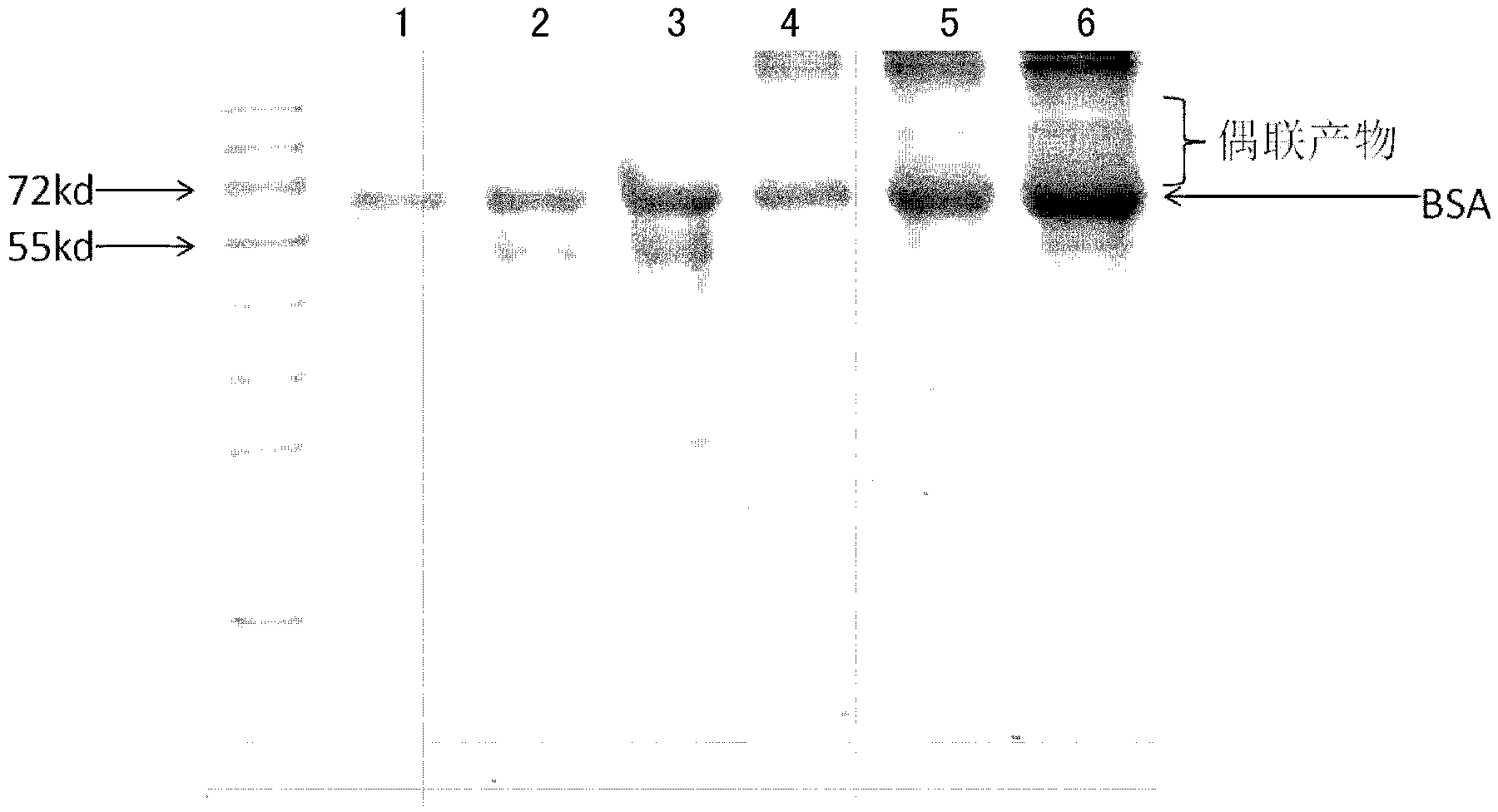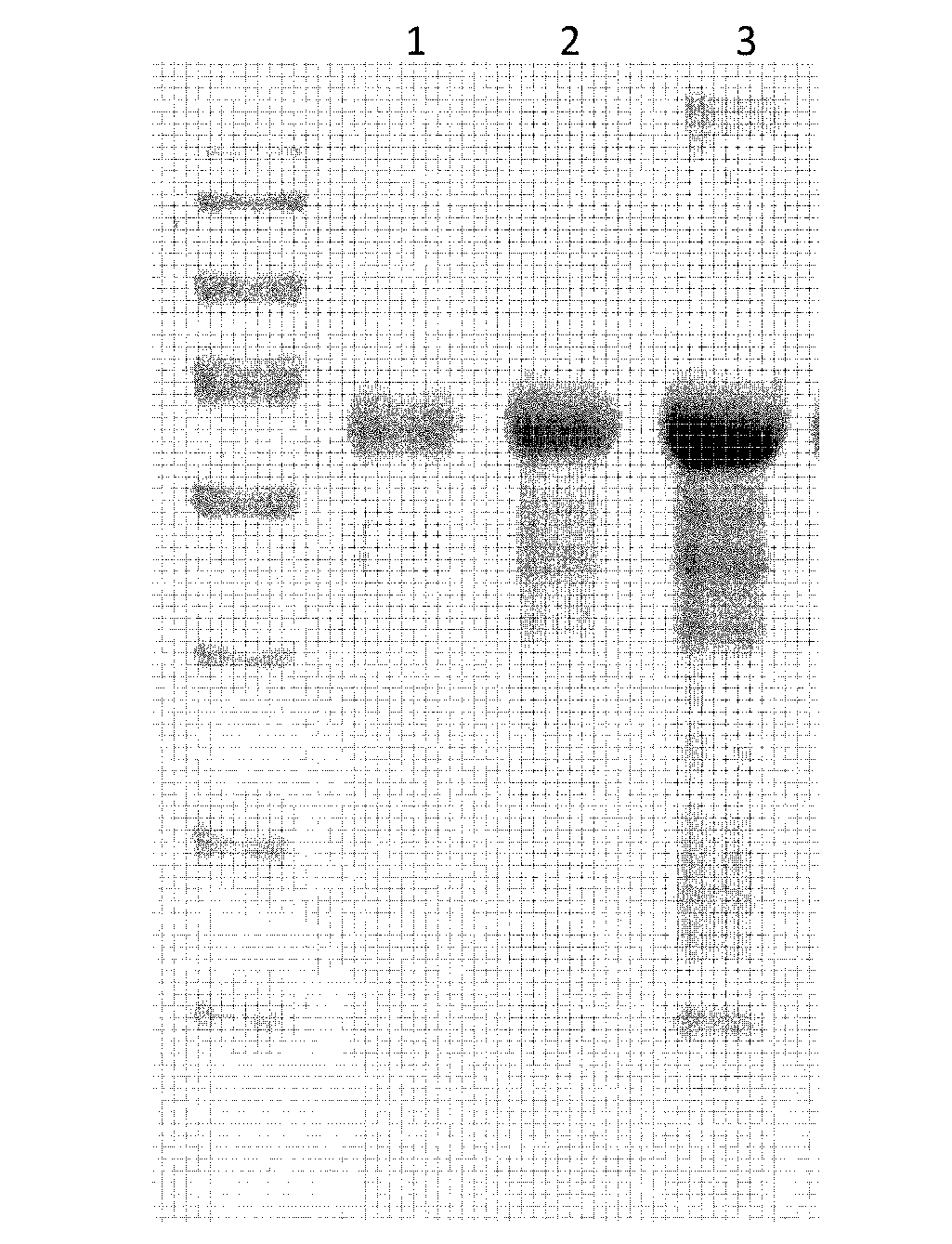Connection method of paralytic shellfish poison and carrier protein
A carrier protein and paralytic technology, which is applied in the field of connection between paralytic shellfish poison and carrier protein, and can solve the problems of no shellfish poison connection and insufficient immunogenicity.
- Summary
- Abstract
- Description
- Claims
- Application Information
AI Technical Summary
Problems solved by technology
Method used
Image
Examples
Embodiment approach
[0031] As a preferred embodiment of the present invention, the method includes: dissolving 1 mg of paralytic shellfish poison C1 & C2 in 500 ul of coupling buffer with a pH value of 5.0-6.0, adding 1-10 mg of carrier protein, mixing, and then adding 37% formaldehyde Solution 20ul, mixed reaction for 72 hours; and paralytic shellfish poison C1 & C2 and carrier protein coupling product into a dialysis bag, dialyzed with pH7.2 PBS solution at 4 ° C for 72 hours, during which the dialysate was changed 3 times. Finally, a step of identifying the dialysis product by electrophoresis may also be included.
[0032] The inventors found in experiments that an appropriate pH value is critical for the successful coupling of paralytic shellfish poisons C1 & C2 to carrier proteins. When the pH is lower than 5, the coupling efficiency is very low, and it is difficult to obtain stable coupling products.
[0033] In the present invention, the C1&C2-carrier protein coupling product prepared by ...
Embodiment 1
[0039] Example 1, the extraction and purification of paralytic shellfish toxin
[0040] 1. Reagents and materials
[0041] Eluent: 2mM tetrabutylammonium phosphate solution, adjust the pH to 6.0.
[0042] Oxidant: 50mM dipotassium hydrogen phosphate buffer containing 7mM periodate, pH 9.0;
[0043] Acidifying agent: 0.5M acetic acid solution.
[0044] Other conventional chemical reagents: glacial acetic acid, acetone, absolute ethanol.
[0045] 2. Culture of algae
[0046] Alexandrium.Tamarense is used for the production of toxin C (paralytic shellfish poison C1 & C2). Take 25ml of algae liquid, centrifuge at 4000g, 20°C for 10min, discard the supernatant, add 500ul of 50mM acetic acid to the lower layer of algae cells and store at -20°C or extract the toxin immediately, and determine the toxin content by HPLC analysis. When the toxin content reached the highest level, the algae cells were collected with a 10-micron sieve and stored at -20°C for the next step of extractin...
Embodiment 2
[0066] Embodiment 2, the coupling method of paralytic shellfish poison C1&C2 and carrier protein
[0067] (1) Dissolve 1mg of paralytic shellfish poison C1&C2 in 500ul of coupling buffer (weigh 16.4g of sodium acetate, dissolve in 1000ml of deionized water, adjust the pH value to 5.0 with glacial acetic acid), add 5mg of carrier protein BSA, mix Uniformly, then add 20ul of 37% formaldehyde solution, mix and react for 72 hours.
[0068] (2) The paralytic shellfish poison C1&C2-carrier protein coupling product was put into a dialysis bag, and dialyzed with PBS solution of pH 7.2 at 4°C for 72 hours, during which the dialysate was changed 3 times.
[0069] (3) The paralytic shellfish poison C1&C2-carrier protein coupling product after dialysis is identified by electrophoresis, and it is determined that the successfully coupled protein has been obtained efficiently, such as figure 1 . From figure 1 It can be seen from the figure that in the sample after the reaction, there are ...
PUM
 Login to View More
Login to View More Abstract
Description
Claims
Application Information
 Login to View More
Login to View More - R&D Engineer
- R&D Manager
- IP Professional
- Industry Leading Data Capabilities
- Powerful AI technology
- Patent DNA Extraction
Browse by: Latest US Patents, China's latest patents, Technical Efficacy Thesaurus, Application Domain, Technology Topic, Popular Technical Reports.
© 2024 PatSnap. All rights reserved.Legal|Privacy policy|Modern Slavery Act Transparency Statement|Sitemap|About US| Contact US: help@patsnap.com









